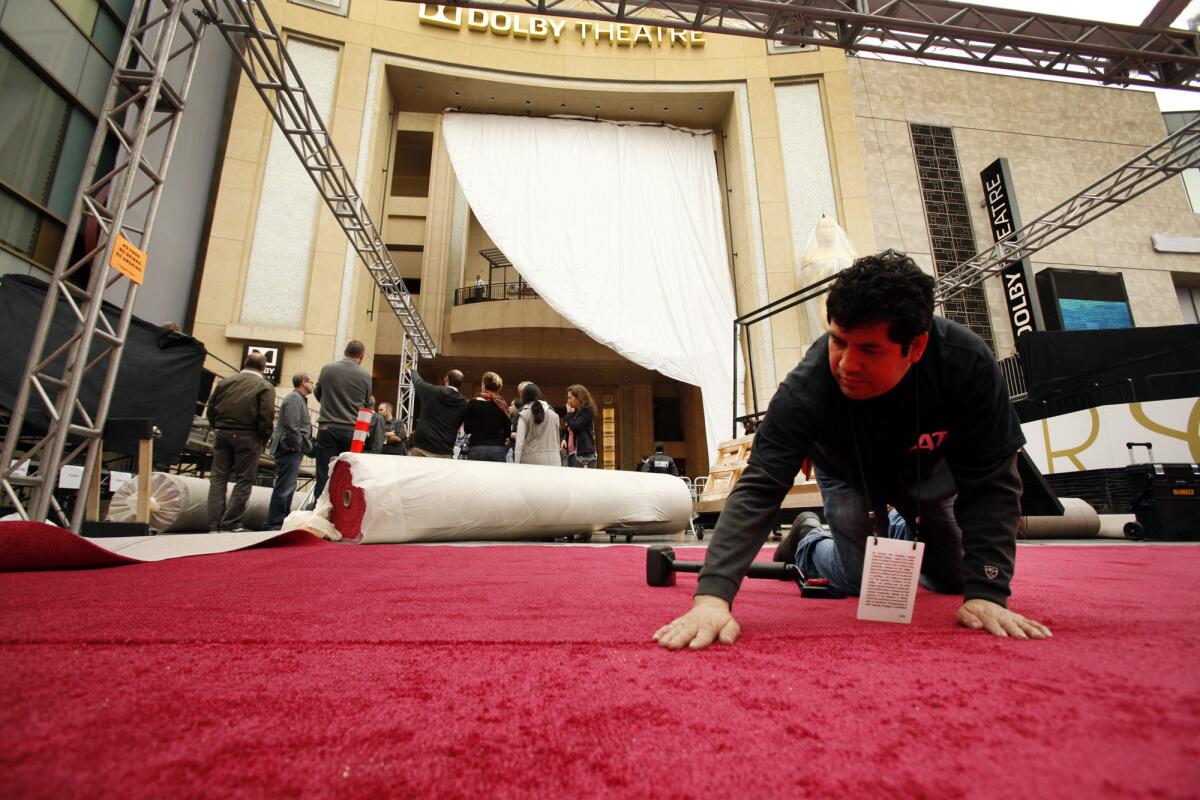Oscar night no gala for film, TV workers hit by runaway production

Tom Capizzi is going to Hollywood Sunday night for the 86th Academy Awards, but not in a limo or a tux.
Instead, he will be protesting near the Dolby Theatre, hoisting a green sign saying “Chase Talent Not Subsidies.”
Capizzi will be among hundreds of visual effects workers staging a pre-Oscar rally, hoping to bring attention to the plight of rank-and-file entertainment industry workers who have been hard hit by the flight of film and TV jobs to other states and countries offering rich incentives.
As Hollywood royalty gathers to celebrate what many are calling the best cinema year in a generation, the industry’s middle class is struggling through one of the worst periods in decades.
“I still love visual effects and my craft, but it just kind of hurts to watch these films because studios have clearly gone out of their way to outsource our work,” said Capizzi, a veteran visual effects technician who was among hundreds laid off last year from Rhythm & Hues Studios Inc., the Oscar-winning visual effects house in El Segundo that filed for bankruptcy protection after losing business to rivals in Canada and Britain.
For many local set decorators, carpenters, camera operators and visual effects workers, the Oscar festivities will do little to affect their shrinking incomes as more films and TV shows, and the post-production work that goes with them, are made in Louisiana, Georgia, New York, London and Vancouver, Canada.
The Oscar nominees themselves are stark evidence of this so-called runaway production. Among the nine best picture contenders, only Spike Jonze’s “Her” was filmed mainly in California.
PHOTOS: Oscars 2014 Top nominees and winners | Presenters and performers
“The climate is one of frustration and, in some cases, desperation,” said Ed Brown, business agent for Local 44 of the International Alliance of Theatrical Stage Employees, which represents prop makers, set decorators and special effects workers. “We’ve got people losing their homes.”
Capizzi was one. After losing his $110,000-a-year job at Rhythm & Hues, he struggled to find work despite his 16 years in the business and credits as a lighting specialist and digital effects artist on “X Men 2,” “The Hunger Games” and other movies.
To stay afloat, he had to sell his house in Culver City and now lives in a Baldwin Hills apartment. His two teenage boys moved to Ohio to live with his ex-in-laws. His unemployment checks ran out in December and now he’s living off his retirement savings.
“I lost everything,” said Capizzi, 55.
A report released by the Milken Institute last week shows that California lost 16,137 film and TV industry jobs from 2004 to 2012 — an 11% decrease — while New York saw its entertainment sector expand by 10,675 jobs, or 25%, as the Empire State expanded its film and TV tax credit program.
New York state allocates $420 million annually to attract film and TV projects, four times as much as California. Last week, state officials there announced another coup, saying the new Netflix production of the Disney/Marvel superhero series “Flawed Heroes of Hell’s Kitchen” will be shot in New York City.
ON LOCATION: Where the cameras roll
The Times reported recently that the number of top-grossing movies that filmed in California dropped 60% in the last 15 years as states and countries lured productions away with tax credits and rebates.
Even major features set in California are often filmed elsewhere. The Google Inc.-themed comedy “Internship” was filmed mainly in Georgia instead of Silicon Valley. The Dwayne Johnson disaster movie “San Andreas,” about a massive earthquake that strikes California, is set to film in Australia to take advantage of that country’s tax credits.
Kevin Klowden, managing economist for the Milken Institute, said the entertainment industry job losses are significant because they pay so well — averaging nearly $98,500 per person and supporting a host of secondary jobs, such as those at catering firms and prop houses, that benefit the broader L.A. economy.
“We’re not talking about big producers or stars,” Klowden said. “These jobs make it possible for families and for working professionals to earn a middle-class living.”
Tensions over so-called runaway production have been building for years, but the topic has gained a new sense of urgency as entertainment guilds and film industry advocates mount a campaign to highlight the problem. Los Angeles Mayor Eric Garcetti has made the issue one of his top priorities in Sacramento and recently appointed Ken Ziffren as his film czar, replacing the late Tom Sherak.
APPRECIATION: Tom Sherak’s passing is a loss to L.A.’s film industry
They are seeking to more aggressively market L.A. as a film destination and persuade lawmakers in Sacramento to bolster California’s film and TV tax credit program.
“It will be a major task to accomplish this in the next six months,” Ziffren said. “However, if we’re able to educate people about the issues, I’m convinced that on the merits, we’ll be successful.”
Last week, 1,500 film industry workers gathered at the Pickwick Gardens Conference Center in Burbank to rally support for recently introduced legislation that would improve upon a film program first introduced in 2009 under former Gov. Arnold Schwarzenegger.
The bill would increase funding beyond the current $100 million annually that California awards, and allow big-budget studio movies and new television dramas to qualify for the incentives.
The visual effects workers protesting Sunday, meanwhile, are seeking to end foreign subsidies. They’ve hired a Washington law firm to challenge the legality of film subsidies in the U.S. Court of International Trade, with the goal that the court would impose duties on production companies that receive tax breaks in foreign countries.
Hollywood does, to some degree, take care of its own. The Actors Fund, a nonprofit group that provides social and economic assistance to entertainment industry workers, has seen a surge in demand for its services, which include job counseling and paying for groceries and rent.
PHOTOS: Behind the scenes of movies and TV
In 2013, the group provided emergency assistance to 1,778 people in the western region (which is mainly California), a 45% increase from 2010, said the fund’s regional director, Keith McNutt.
The Actors Fund also has helped some crew members find jobs outside the industry. Among them is Reagan Wilks, a former prop maker and actor who quit the business in January after he lost his job on the Nickelodeon show “Big Time Rush.”
Wilks, who once made a six-figure income at Universal Studios, where he helped to rebuild the New York City back lot, had been out of work six months before he landed a job on “Big Time Rush.”
But that job lasted less than two months.
“It was bleak,” Wilks said, “There was no future in it for me.”
With the fund’s help, the 50-year-old Highland Park resident left the industry entirely. He now works as a site supervisor for a home construction company, and has no intention of returning to Hollywood.
Other local workers, in order to keep working, have had to begin a migratory existence, spending months at a time away from their families.
Until a few weeks ago, prop maker A.J. Ransdell had been working in Georgia on the set of the latest “Hunger Games” movie. But after being away from his wife and 11-year-old daughter for six months, the Long Beach resident quit his job and returned to California.
PHOTOS: Box office top 10 of 2013 | Biggest flops of 2013
“I couldn’t deal with it anymore,’’ said Ransdell, 49. “When you’re watching your daughter getting taller on Skype, your dog getting older, and your wife tearing up and you hanging up in tears — it takes its toll on you.”
“We’d go out and visit him every six weeks, but it was just too much on us,” said his wife, Tami. “I was on the verge of a nervous breakdown.”
Ransdell recently got an offer to work on the Georgia-based AMC series “The Walking Dead” and is contemplating moving his entire family to Atlanta.
He doesn’t want to leave — “This is our home,” he said — but he has little choice because jobs are so scarce. The last employment he had locally was two years ago, on “Star Trek Into Darkness.”
“I’m scavenging for work,” he said.
Ransdell is more fortunate than most. His 25-year seniority makes it possible for him to work outside California. Union rules and pressure from producers to hire locals has made it increasingly difficult for California employees to work in other states unless they become residents there. Working on big-budget movies in Britain and Canada is even harder.
Even so, 1,694 California members of the International Alliance of Theatrical Stage Employees union have moved to Georgia and other incentive-rich states in the last four years, a 33% increase over the previous four years, Brown of the union local said.
Those who remain in L.A. compete for a dwindling number of lower-paying jobs on low-budget features, reality TV programs or Web series. Some crew members have seen a 40% decline in their incomes in the last five years, Brown said.
“Before, people were happy. They were making good money, they could keep up with their bills, they had a future,” said Susan Cabral-Ebert, president of Local 706, which represents makeup artists and hairstylists. “Now it’s become almost a part-time job rather than a career.”
More to Read
From the Oscars to the Emmys.
Get the Envelope newsletter for exclusive awards season coverage, behind-the-scenes stories from the Envelope podcast and columnist Glenn Whipp’s must-read analysis.
You may occasionally receive promotional content from the Los Angeles Times.











